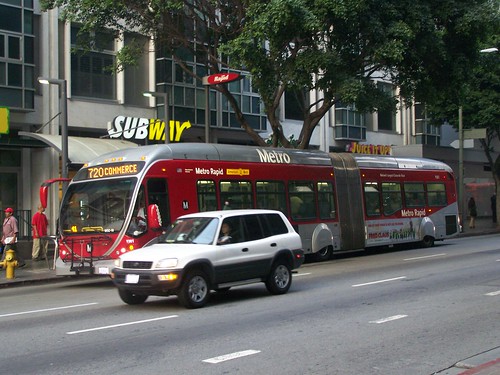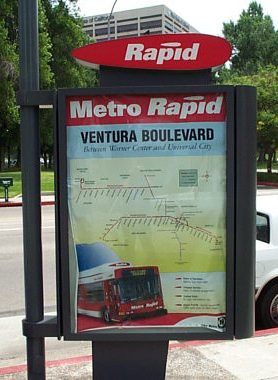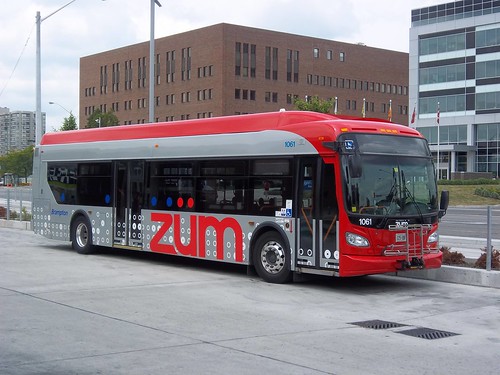Bus transit, for choice riders
In my blog entry ("Detroit in Underdrive") on Detroit's decision to not build light rail but to do "bus rapid transit," Brian Morrisey criticizes the entry in comments (on my home computer some bug prevents me from using the comment function) saying that it's
I don't think it's disingenuous, just reality.
Only in Pittsburgh does BRT function mostly like how BRT does in South America, with one major exception, there isn't pre-payment before bus entry, and the buses don't have low floors with multiple entry doors.
Most of what we might call BRT in the U.S. is more what I've called "bus rapider transit" but maybe is better termed "branded bus transit," where the buses have attractive livery designs (like the DC Circulator), more attractive bus shelters, and better branding campaigns, including the provision of signage, mapping, etc.

Metro Rapid bus, Wilshire Blvd., Los Angeles.

Bus shelter, Silver Line BRT, Boston. Photo by Steve Pinkus.

Metro Rapid map sign, Los Angeles. Photo: TBSH.
Here's a resource I just came across but haven't read yet, Developing the Next Frontier: Capitalizing on Bus Rapid Transit to Build Community, which is a ULI task group report evaluating the opportunity for development in association with new BRT services in Seattle.
Plus there is the EMBARQ: The World Resources Institute Center for Sustainable Transport report on transit (bus) marketing, which is very good as well, From Here to There: A creative guide to making public transport the way to go.
This is an issue too with inter-city bus services vs. railroad transportation.
I find it interesting that conservative newspapers like the Washington Examiner continually push bus "rapid transit" over fixed rail transit.
From the editorial:
The cost of the 15-mile CCT "train on rubber wheels" -- including dedicated lanes -- is about $491 million. Compare that to the $1.93 billion it will cost for the 16-mile Purple Line connecting Bethesda to New Carrollton, or the $2.2 billion for Baltimore's 14-mile Red Line. These two light rail projects are sucking up state and federal transit funding. Had state and county officials chosen BRT instead, they would have had enough money to build the Purple and Red Lines and the CCT -- with $3.2 billion to spare.
Detroit also planned to spend $528 million on a 9.3-mile light rail line serving its hollowed-out urban core, but city officials wisely pulled back because of very real concerns that Detroit could not afford the light rail line's annual operating costs. They are now shifting $500 million to a 110-mile BRT system that will connect three counties and the airport, and help 60 percent of still-employed city residents get to their suburban jobs. Motor City will soon have largest BRT system in the nation, joining other cities with successful BRT lines such as Cleveland, Pittsburgh, Los Angeles and Vancouver, British Columbia
Since BRT is so much cheaper and way more flexible, and provides mass transit to a much larger area for the same capital costs, why would any public official even consider fixed rail?
BRT is cheaper and arguably it is more flexible, but the reality is that cheap and flexible aren't the right questions, especially if you are focused on maximizing use, not minimizing initial cost.
1. More people ride fixed rail transit than buses;
3. Fixed rail transit investment repositions communities around transit and within their respective regions as choice locations--this is an essential and key difference between the modes;
But I would argue that in order to generate these benefits, you need to have a network of fixed rail transit, one or two lines isn't really enough, at least for communities on a significant downward spiral. For example DC vs. Baltimore. Both were declining cities when subway systems were first proposed.
The Washington Times ran an op-ed by James Bacon of Virginia's Bacon's Rebellion blog, "The intercity bus revolution," highlighting the success of entrepreneurial inter-city bus services over more expensive railroad-based services. From the article:
While President Obama dreams about spending hundreds of billions of public dollars building a high-speed, intercity rail network, an entrepreneurial revolution in the old-timey bus industry is scoring dramatic gains in market share for intercity travel - without government subsidies.
After decades of losing customers, the intercity bus industry began experiencing an entrepreneurial renaissance in the mid-2000s. And 2011 was the best year yet. According to a study published by DePaul University’s Chaddick Institute for Metropolitan Development, intercity bus was the only major long-distance passenger mode to grow appreciably this year. Daily intercity bus operations expanded by 7.1 percent.
Railroads and airlines use a dedicated infrastructure, which is more costly, but also allows these modes to travel much faster (ideally, in the case of railroads, where dedicated right of way without crossings doesn't always exist) than buses.
Plus high speed railroad service is being developed to provide alternatives to air travel, given concerns about reduced access to oil, and even if it is true that oil production will increase because of new technologies, the fact remains that concerns over greenhouse gas emissions encourage the consideration of railroad travel, not to mention the fact that providing airline service and airports is economically costly--as an industry, airlines have mostly lost money throughout the industry's entire existence, with some exceptions like Southwest Airlines.
Labels: transportation planning




0 Comments:
Post a Comment
<< Home